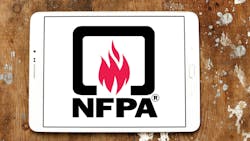This annex summarizes four methods in D.2 through D.5. They are:
D.2. Ralph Lee Calculation Method. This method is often preferred for systems that are outside of the IEEE 1584-2018 range of model. It’s named after Dr. Ralph H. Lee, an influential figure in arc flash study. His landmark paper, “The Other Electrical Hazard: Electric Arc Blast Burns,” was published in 1982. In D.2., you’ll find basic equations, sample calculations, and calculations of incident energy exposure greater than 600V for an arc flash hazard analysis. There are two tables and a single-line diagram along with this.
D.3. Doughty Neal Paper. If you know the maximum bolted fault current and want to determine the energy at a given distance (e.g., where the exposed worker will be working), this method will provide the correct answer. This paper was written by A. Bingham, R. Doughty, and T. Neal in the mid-1990s. They used empirical test data at various distances from a fault. In D.3, you’ll see how to estimate the incident energy for an arc in open air versus one in a cubic box.
D.4. IEEE 1584-2018 Calculation Method. If your parameters fit the model range of parameters used in this method, this is a good method to use. It is not recommended to attempt using the equations for conditions outside the stated test ranges. In D.4, you get some good background information on using this method. That includes Table D.4.4., which provides the range of input parameters.
D.5. Direct Current Incident Energy Calculations. You would use this when you want to calculate dc arc flash incident energy. As D.5.1 says, “This method is based on the concept that the maximum power possible in a dc arc will occur when the arcing voltage is one-half the system voltage.”
Annex D doesn’t teach you how to perform these calculations. It gives you an overview, which in itself is useful even if you never aspire to being a “qualified person” when it comes to actually performing these calculations. Understanding some of what is involved in these calculations is good because you have a deeper understanding of what those numbers mean and how even small changes may affect you.
About the Author

Mark Lamendola
Mark is an expert in maintenance management, having racked up an impressive track record during his time working in the field. He also has extensive knowledge of, and practical expertise with, the National Electrical Code (NEC). Through his consulting business, he provides articles and training materials on electrical topics, specializing in making difficult subjects easy to understand and focusing on the practical aspects of electrical work.
Prior to starting his own business, Mark served as the Technical Editor on EC&M for six years, worked three years in nuclear maintenance, six years as a contract project engineer/project manager, three years as a systems engineer, and three years in plant maintenance management.
Mark earned an AAS degree from Rock Valley College, a BSEET from Columbia Pacific University, and an MBA from Lake Erie College. He’s also completed several related certifications over the years and even was formerly licensed as a Master Electrician. He is a Senior Member of the IEEE and past Chairman of the Kansas City Chapters of both the IEEE and the IEEE Computer Society. Mark also served as the program director for, a board member of, and webmaster of, the Midwest Chapter of the 7x24 Exchange. He has also held memberships with the following organizations: NETA, NFPA, International Association of Webmasters, and Institute of Certified Professional Managers.
